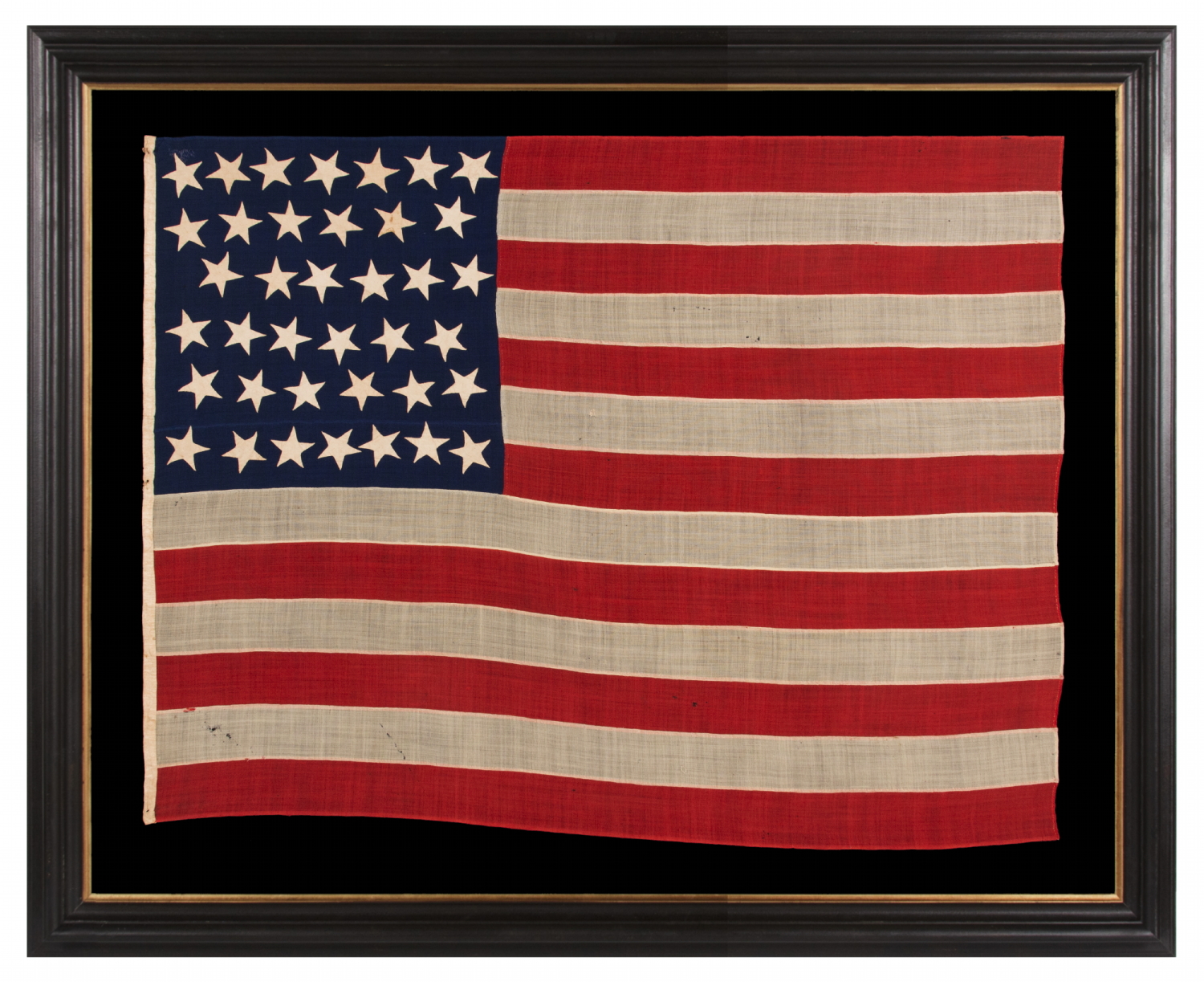
| |
ENTIRELY HAND-SEWN, 38 STAR, ANTIQUE AMERICAN FLAG OF THE INDIAN WARS PERIOD, WITH A SQUARISH PROFILE AND A CANTON THAT IS TALLER THAN IT IS WIDE, SIMILAR TO U.S. INFANTRY AND ARTILLERY BATTLE FLAGS, AND WITH AN ESPECIALLY GRAPHIC PRESENTATIONOF STARS; MADE IN THE ERA WHEN COLORADO WAS THE MOST RECENT STATE TO JOIN THE UNION, 1876-1889 |
|
| Available: |
Sold |
| Frame Size (H x L): |
Approx. 54.5" x 67" |
| Flag Size (H x L): |
42.5" x 55" |
|
| Description....: |
|
38 star antique American flag, with an array of interesting and visually impressive features. Entirely hand-sewn, note how the flag’s dimensions appear near-to-square, when compared to most of its counterparts. Also note how the canton is slightly taller than it is wide. These traits mimic the visual aspects of infantry and artillery battle flags of the 18th- early 20th centuries, that were basically square in shape, with cantons that were far more narrow than what one would expect. U.S. Army regulations of 1861 (opening year of the Civil War), for example, specified that both regimental and national colors be 6 x 6.5 feet. This shape maximized the surface area of the textile when carried on foot. Favorable for ground use, it allowed the flag to be as large as possible, in order to maximize its visibility as a signal, yet at the same time not drag on the ground.
At approximately 3.5 x 4.5 feet, this particular flag has a similar appearance, yet is significantly smaller. Entirely hand-sewn, it measures approximately 3/5 of the scale of a regulation, infantry battle flag. Note how the stars, while roughly arranged in rows of 7-6-6-6-6-7, are spun in all directions on their vertical axis, and how their placement within each row is grossly inconsistent. Two of the most notable occurrences of variation can be seen at the beginning of the third row, where enough space was left to easily add another star (not possible elsewhere), and in the final row of 7, where the 4th and 5th stars from the hoist, practically touch.
The flag has terrific presentation as a result of the above features, stronger and more unusual than most examples of the time.
The stars of the flag are made of cotton and are double-appliquéd, meaning that they are applied to both sides of the blue canton. The canton and stripes of the flag are made of wool bunting. There is a narrow binding along the hoist, made of either linen or hemp, with three, tiny, hand-sewn, whip-stitched grommets. Remnants of hemp rope are present in the top and center grommets.
Colorado became the 38th state on August 1st, 1876. This was the year of our nation’s 100-year anniversary of independence. Per the Third Flag Act of 1818, stars were not officially added until the 4th of July following a state's addition. For this reason, 37 was the official star count for the American flag in 1876. Flag-making was a competitive venture, however, and few flag-makers would have been continuing to produce 37 star flags, when their competitors were making 38’s. It is for this reason that 38 and 13 stars (to represent the original 13 colonies) are more frequently encountered at the Centennial International Exposition, the six-month long World’s Fair, held in Philadelphia, in honor of the event.
Some flag-makers would have been adding a star for the 38th state even before it entered the Union, in the early part of 1876 or even prior. In fact, many makers of printed parade flags were actually producing 39 star examples, in hopeful anticipation of the addition of two more Western Territories instead of one. The 39th state would not join the Union for another 13 years, however, when the Dakota Territory entered as two states (numbers 39 and 40) on the same day, on November 2nd, 1889.
Mounting: The flag was stitched to 100% silk organza on every seam and throughout the star field for support. It was then sewn to a background of 100% cotton twill, black in color, which was washed to remove excess dye. An acid-free agent was added to the wash to further set the dye and the fabric was heat-treated for the same purpose. The mount was then placed in a black-painted, hand-gilded and distressed Italian molding. The glazing is U.V. protective Plexiglas.
Condition: There is very minor mothing in the striped field, accompanied by an area of minor to modest of the same, near the hoist end of the last white stripe. There is a darning repair in the upper, hoist end corner of the canton. There minor soiling along the binding and in a few of the white stars, and modest of the same in the 5th white star from the hoist, in the 2nd row. The overall condition is exceptional for a wool flag of this period. |
|
|
|
| Collector Level: |
Advanced Collectors and the Person with Everything |
|
| Flag Type: |
Sewn flag |
|
| Star Count: |
38 |
|
| Earliest Date of Origin: |
1876 |
|
| Latest Date of Origin: |
1889 |
|
| State/Affiliation: |
Colorado |
|
| War Association: |
1866-1890 Indian Wars |
|
| Price: |
SOLD |
|
| |
Views: 152 |
|
|
|

